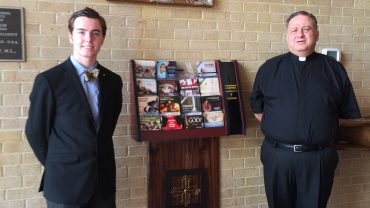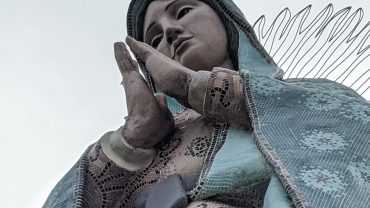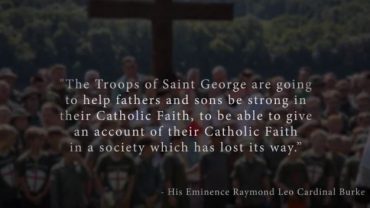

(June 5, 2018) — For most adult Catholics over the age of 50, the traditional Eucharistic procession on the Solemnity of Corpus Christi was part of the rhythm of the Church’s liturgical year in their childhood.
As an altar boy during the early 1980s, it struck me that this was the only time we moved the liturgy outside the church building. Corpus Christi Sunday was usually in early June when the grass was lush, and the smell of flowers was in the air. My parish had outside altars built specifically for Corpus Christi Sunday. For a small, poor parish, that was a big deal.
We should make a big deal of the Most Sacred Body and Blood of Our Lord. It is the source and summit of our faith. It’s Jesus Himself. Therefore, it’s everything that matters.
Unfortunately, most altar boys these days don’t have the opportunity to experience a Corpus Christi procession. It’s sad because the procession is a public display of our love for Jesus in the Most Blessed Sacrament.
Two special boy saints had a special devotion to Jesus in Eucharist—and they joyfully gave their lives publicly because of that love.
Saint Tarcisius of Rome
Tarcisius lived in Rome during the third century under the reign of Emperor Valerian. The emperor had many Christians killed. Some were beaten to death, others were burned, and some were thrown into arenas to be eaten by lions.
Christians met secretly in their homes to pray and to learn the faith. They also built underground rooms and passages called catacombs so that they could meet safely. There, they celebrated Holy Mass in secret and buried their dead.
One day, a bishop received a letter from prisoners requesting Holy Communion. They knew that if Jesus was with them, they would be less fearful. The bishop knew it was dangerous to take the Eucharist to prisoners.
Tarcisius, a young boy and altar server, volunteered to take Jesus to them. The bishop was afraid for him, but Tarcisius convinced him that nobody would suspect him because he was so young. The boy carefully wrapped some Hosts in a linen cloth and he set off for the prison. Along the way, he passed a group of his schoolmates.
“What have you there?” said one, seeing how tightly Tarcisius held his hands to his breast. “Let me see.”
“No, no,” cried Tarcisius, struggling to free himself. His anxiety made them all curious, and together they tried to pull away his hands. They beat, stoned, and kicked him, but they could not loosen his grip. Tarcisius cried out to Jesus. Hearing that he was a Christian, they beat him harder.
A soldier heard the commotion and scattered the attackers. Tarcisius recognized him as a fellow Christian. The boy handed his precious treasure to the soldier, who placed it reverently inside his tunic.
“Carry Him to the prison for me,” said Tarcisius, and with a gentle sigh he died.
Saint José Sánchez del Río
In 1928, Mexican soldiers tortured a 14-year-old boy, prodding him to renounce his faith in Jesus Christ. It was during the Cristero War, which began when the government eliminated Church privileges and seized Church properties throughout the country in accordance with anti-clerical laws written into the Mexican Constitution.
José Sánchez del Río was 12 when his brothers joined the rebel forces. He had cultivated a strong devotion to Our Lady of Guadalupe and prayed his rosary devoutly each day. José begged his mother for months to join his brothers in fighting to restore the rights of the Church. “Mother,” he said, “Will you deny me the chance to go to heaven, and so soon?” She finally relented, but José was rejected by the commander of the local force because of his youth.
The leader of another band of Cristero fighters 25 miles away was inspired by the boy’s grit, so he made him an aide to their general. When the general’s horse was killed in battle, José volunteered his horse, allowing the general to escape. Mexican soldiers captured the boy, and the captain offered José freedom in exchange for information about the Cristeros. He refused, so they skinned the soles of his feet and forced him to walk to the graveyard, promising to spare him if he denied Our Lord. José died yelling, “Viva Cristo Rey!” — Long live Christ the King!
José’s witness — told in the 2012 film For Greater Glory — is among the most compelling of the past century. At a time when Christian, and in particular Catholic, beliefs are under attack, we can draw strength from his profound faith.
At the boy’s canonization Mass in 2016, Pope Francis reminded us that in order to be great saints, we must be people of deep prayer. Saints, he said, “struggle to the very end with all their strength, and they triumph, but not by their own efforts: The Lord triumphs in them and with them.”
Scripture encourages us to move forward in confidence. “Since we are surrounded by so great a cloud of witnesses, let us … persevere in running the race that lies before us” (Heb 12:1). The winds of our secular culture may be blowing hard against us, but the Church offers us a rock upon which we will always find firm footing.
—
These holy boys are a profound example of how love for Jesus in the Eucharist is completely transforming. They should inspire us to give all to Jesus every day—and to visit him in the tabernacle as often as possible. It should also inspire parishes to bring back the Corpus Christi Eucharistic procession!



